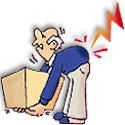|
Back belts have become a common sight - we see them every
day on vending machine stockers, deliverymen, and anyone else
who regularly lifts heavy objects. Back belts were originally
touted
as an effective means of preventing back problems, but since
have been said to have no effect on proper lifting techniques,
making it difficult to decide whether or not to use one. A
recent study once again proves the usefulness of back belts,
however.
The authors of the study evaluated the effects of an elastic
back belt on spine motion when lifting large and small boxes
of the same weight (about 20 lbs). Twenty-eight subjects with
no prior low back pain and at least six months of manual-handling
experience lifted small and large boxes with and without a
back belt. The boxes were lifted from a position near the
ground in front of the subjects to a position at table-height
to the subjectís right side.
 Back belt use significantly reduced twisting of the spine
when lifting large boxes. Back belts also clearly decreased
spinal bending and speed of lifting when lifting both large
and small boxes. Properly lifting while wearing a belt did
not lead to proper lifting techniques once the belt was removed,
indicating the importance of continued use. Back belt use significantly reduced twisting of the spine
when lifting large boxes. Back belts also clearly decreased
spinal bending and speed of lifting when lifting both large
and small boxes. Properly lifting while wearing a belt did
not lead to proper lifting techniques once the belt was removed,
indicating the importance of continued use.
This study supports prior research emphasizing the value
of wearing back belts for manual lifting tasks; belts appear
to result in slower lifts, proper squat-lift technique, and
reduced torso motions. Whether or not you use a belt, always
follow proper lifting techniques: lift with your legs, not
with your back. If you ever need to lift moderate-to-heavy
objects at work or at home, be sure to wear a back belt. Itís
a small price to pay, compared to costly and painful back
injuries.
Reference:
Giorcelli RJ, Hughes RE, Wassell JT, et al. The effect of
wearing a back belt on spine kinematics during asymmetric
lifting of large and small boxes. Spine, August 15,
2001:26(16), pp. 1794-1798.
|



